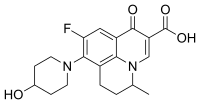Chemistry:Nadifloxacin
 | |
| Clinical data | |
|---|---|
| AHFS/Drugs.com | International Drug Names |
| Routes of administration | topical (epicutaneous) |
| ATC code | |
| Identifiers | |
| |
| CAS Number | |
| PubChem CID | |
| ChemSpider | |
| UNII | |
| Chemical and physical data | |
| Formula | C19H21FN2O4 |
| Molar mass | 360.385 g·mol−1 |
| 3D model (JSmol) | |
| Chirality | Racemic mixture |
| Melting point | 245 to 247 °C (473 to 477 °F) (dec.) |
| |
| |
| | |
Nadifloxacin (INN, brand names Acuatim, Nadiflox, Nadoxin, Nadixa, Activon) is a topical fluoroquinolone antibiotic for the treatment of acne vulgaris.[1] It is also used to treat bacterial skin infections.
Pharmacology
Antibacterial spectrum
In vitro studies of nadifloxacin showed potent and broad-spectrum antibacterial activity against aerobic Gram-positive, Gram-negative and anaerobic bacteria, including Cutibacterium acnes and Staphylococcus epidermidis. Nadifloxacinshowed potent antibacterial activity against methicillin-resistant Staphylococcus aureus (MRSA), which was similar to potency against methicillin-sensitive Staphylococcus aureus (MSSA). The drug was also active against new quinolone-resistant MRSA. Nadifloxacin does not show cross-resistance with other new fluoroquinolones.[citation needed]
Mechanism of action
Nadifloxacin inhibits the enzyme DNA gyrase that is involved in bacterial DNA synthesis and replication, thus inhibiting the bacterial multiplication. Nadifloxacin in addition to determine a therapeutic antibacterial action, can have a sebostatic and anti-inflammatory action, thus contributing to the improvement of the clinical condition of the patient.[2][3][4]
Pharmacokinetics
Following a single topical application of 10 g nadifloxacin 1% cream to normal human back skin, the highest plasma concentration was determined to be 107 ng/mL with an elimination half-life of 19.4 hours. Approximately 0.09% of the administered dose was excreted in the urine over 48 hours post- dosing. The plasma concentration reached a steady state on Day 5 of repeated administration study when nadifloxacin 1% cream was applied at 5 g twice daily to normal healthy individuals for a period of 7 days. The plasma concentration reached a peak of 4.1 ng/ml at 8 hours post-final dosing with an elimination half-life of 23.2 hours. The urinary excretion rate reached 0.16% on Day 7.
Clinical use
In some European countries, the drug has been approved for the treatment of acne vulgaris.[5] In a 2013 multicenter, randomized clinical study with a total of 184 Japanese patients with moderate to severe acne, adapalene 0.1% gel plus nadifloxacin 1% cream (combination therapy) showed a significant efficacy in decrement of inflammatory papulopustular lesions.[6] In patients with skin lesions, topical application of nadifloxacin can result in plasma concentrations of 1 to 3 ng/ml. Consequently, some authors argued that it should not be used to treat relatively harmless diseases like acne vulgaris, risking the development of quinolone resistances.[7]
Adverse effects
During the treatment some patients may develop some adverse effects predominantly of the skin and subcutaneous tissue: burning and itching (in absolute the most common side effect), contact dermatitis, dryness and skin irritation.[8]
References
- ↑ "[Anti-microbial therapies for acne vulgaris: anti-inflammatory actions of anti-microbial drugs and their effectiveness]" (in ja). Journal of UOEH 29 (1): 63–71. March 2007. doi:10.7888/juoeh.29.63. PMID 17380730.
- ↑ "Nadifloxacin, an antiacne quinolone antimicrobial, inhibits the production of proinflammatory cytokines by human peripheral blood mononuclear cells and normal human keratinocytes". Journal of Dermatological Science 38 (1): 47–55. April 2005. doi:10.1016/j.jdermsci.2005.01.002. PMID 15795123.
- ↑ "Clinical and histological evaluation of 1% nadifloxacin cream in the treatment of acne vulgaris in Korean patients". International Journal of Dermatology 50 (3): 350–357. March 2011. doi:10.1111/j.1365-4632.2010.04701.x. PMID 21342170.
- ↑ "[Anti-microbial therapies for acne vulgaris: anti-inflammatory actions of anti-microbial drugs and their effectiveness]" (in ja). Journal of UOEH 29 (1): 63–71. March 2007. doi:10.7888/juoeh.29.63. PMID 17380730.
- ↑ "Clinical and bacteriological evaluation of nadifloxacin 1% cream in patients with acne vulgaris: a double-blind, phase III comparison study versus erythromycin 2% cream". European Journal of Dermatology 16 (1): 48–55. 2006. PMID 16436342. http://www.john-libbey-eurotext.fr/medline.md?issn=1167-1122&vol=16&iss=1&page=48. Retrieved 2014-09-28.
- ↑ "Clinical and bacteriological evaluation of adapalene 0.1% gel plus nadifloxacin 1% cream versus adapalene 0.1% gel in patients with acne vulgaris". The Journal of Dermatology 40 (8): 620–625. August 2013. doi:10.1111/1346-8138.12189. PMID 23724808.
- ↑ Medizinische Chemie: Targets und Arzneistoffe. Deutscher Apotheker Verlag WVG Stuttgart. 2005. ISBN 978-3-7692-3483-1.
- ↑ "Efficacy and safety of nadifloxacin for bacterial skin infections: results from clinical and post-marketing studies". Dermatology and Therapy 4 (2): 233–248. December 2014. doi:10.1007/s13555-014-0062-1. PMID 25212256.
 |

